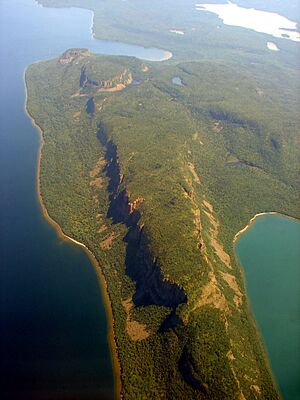Sibley Peninsula facts for kids
The Sibley Peninsula is a long piece of land that sticks out into Lake Superior in Ontario, Canada. It's about 52 kilometers (32 miles) long and 10 kilometers (6 miles) wide. This peninsula separates Thunder Bay on its west side from Black Bay on its east side. Most of the peninsula is covered by Sleeping Giant Provincial Park.
The famous Sleeping Giant rock formation is at the very end of the peninsula. It looks like a huge person lying on their back. Inside the park, there are 20 different kinds of native fish living in the lakes.
You can also find the Thunder Cape Bird Observatory at the peninsula's southern tip. This is a place where scientists study birds. The small town of Silver Islet is also on the peninsula. You can get there by following Highway 587 from Highway 17. The peninsula was named after Alexander H. Sibley. He was the president of a company that ran a silver mine here.
What Makes Up the Sibley Peninsula?
The Sibley Peninsula has two main types of land: high areas and low areas. The western part of the peninsula has high areas. These rise about 380 meters (1,247 feet) above Lake Superior. The eastern part has low areas. These are only about 75 meters (246 feet) high. They stretch for about 3 to 6 kilometers (2 to 4 miles) wide.
Most of the peninsula is made of sedimentary rocks. These are rocks formed from layers of sand and mud over millions of years. There are also some diabase rocks. These include long, thin rock formations called dikes. A very large diabase rock layer, called a sill, forms the top part of the Sleeping Giant. The rocks here are tilted. They form a special type of hill called a cuesta.
A Look Back at Sibley Peninsula's History
People have lived on the Sibley Peninsula for a very long time. Archaeologists have found signs of ancient settlements here. These include sites from the Paleoindian, Archaic, and Woodland times.
A big discovery happened in 1868: silver! From 1870 to 1884, the mine at Silver Islet was incredibly rich. It was known as the richest silver mine in the entire world during that time.


